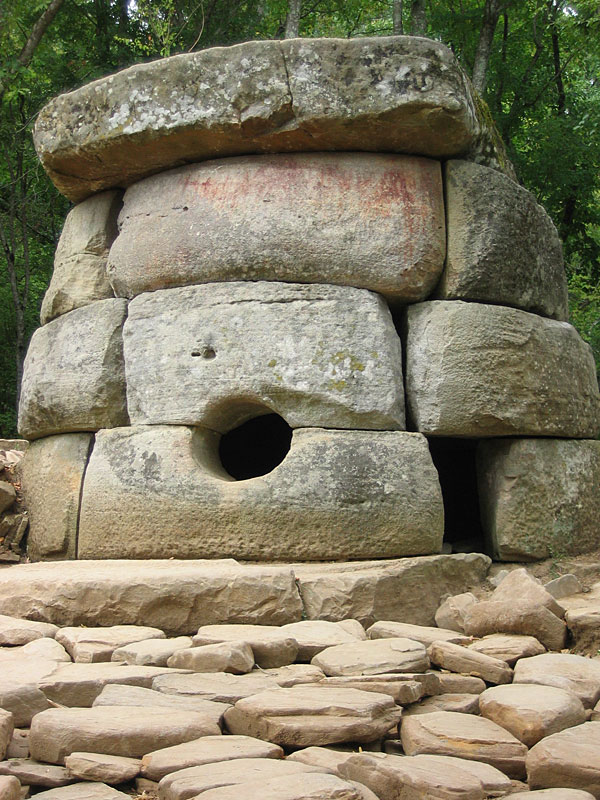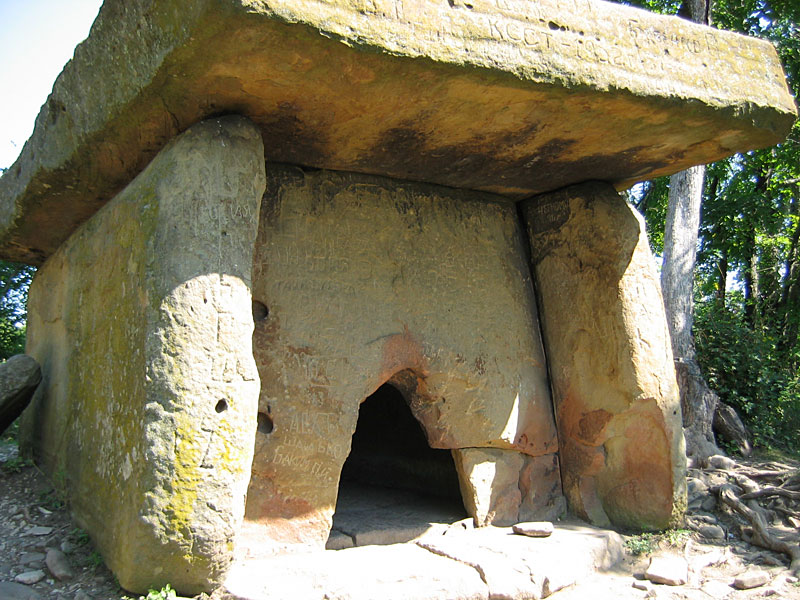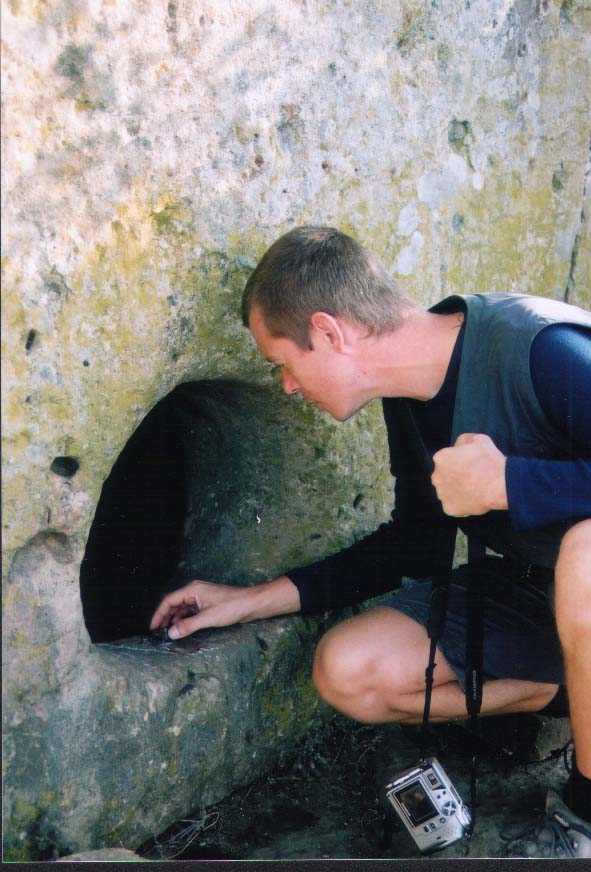In Russia, in the Caucasus mountains, not far from the cities
Tzelentzchik, Touapse, Novorossiysk and Sochi, there are hundreds of
megalithic monuments. The Russians call them dolmens. Russian and
foreign archaeologists have not yet discovered their use. All these
megalithic dolmens you see below in the pictures are dated from 10,000
years to 25,000 years ago, according to the website Kykeon. Other archaeologists put the age of these megalithic structures at 4000 to 6,000 years old.

Credit: The Living Moon
Thousands of prehistoric megalithic monuments are known throughout the
world. Some of the least known outside the former Soviet Union, however,
are those in the Caucasus. These dolmens cover the Western Caucasus on
both sides of the mountain ridge, in an area of approximately 12.000
square kilometers of Russia and Abkhazia.

Credit: The Living Moon
The Caucasian dolmens represent a unique type of prehistoric
architecture, built with precisely dressed cyclopic stone blocks. The
stones were, for example, shaped into 90-degree angles, to be used as
corners or were curved to make a perfect circle. The monuments date
between the end of the 4th millennium and the beginning of the 2nd
millennium B.C.

Credit: The Living Moon
While generally unknown in the rest of Europe, these Russian megaliths
are equal to the great megaliths of Europe in terms of age and quality
of architecture, but are still of an unknown origin.
Credit: Kykeon
The Caucasian dolmens represent a unique type of prehistoric
architecture, built with precisely dressed large stone blocks. The
stones were, for example, shaped into 90-degree angles, to be used as
corners or were curved to make a circle.


Credit: Kykeon
In spite of the variety of Caucasian monuments, they show strong
similarities with megaliths from different parts of Europe and Asia,
like the Iberian Peninsula, France, Great Britain, Ireland, Netherlands,
Germany, Denmark, Sweden, Israel and India. A range of hypotheses has
been put forward to explain these similarities and the building of
megaliths on the whole, but still it remains unclear.


Approximately 3,000 of these megalithic monuments are known in the
Western Caucasus, but more are constantly being found, while more and
more are also being destroyed. Today, many are in great disrepair and
will be completely lost if they are not protected from vandals and
general neglect.
Credit: Kykeon
Credit: Kykeon
Credit: Kykeon
Credit: Kykeon
 Credit: Kykeon
Credit: Kykeon
Credit: Kykeon
Credit: Kykeon
 Credit: Kykeon
Credit: Kykeon
The dolmens are found in the area of Krasnodar. Krasnodar is a city
and the administrative center of Krasnodar Krai, Russia, located on the
Kuban River about 148 kilometers (92 mi) northeast of the Black Sea port
of Novorossiysk.
Concentrations of megaliths, dolmens and stone labyrinths have been
found (but little studied) throughout the Caucasus Mountains, including
the Abkhazia. Most of them are represented by rectangular structures
made of stone slabs or cut in rocks with holes in their facade. These
dolmens cover the Western Caucasus on both sides of the mountain ridge,
in an area of approximately 12.000 square kilometres of Russia and
Abkhazia.
The map above shows locations of known Dolmen structures. The original source for the following images came via a Russian Website
Map of dolmen locations

The dolmens have a limited variety in their architecture. The floor plans are square, trapezoidal, rectangular and round. All of the dolmens are punctuated with a portal in the center of the facade. While round portholes are the most common, square ones are also found. In front of the facade is a court that usually splays out, creating an area where rituals possibly took place. The court is usually outlined by large stone walls, sometimes over a meter high, which enclose the court. It is in this area that Bronze and Iron Age pottery has been found – which helped date these tombs -, along with human remains, bronze tools and silver, gold and semi-precious stone ornaments.

Credit: The Living Moon
The repertoire of decoration for these tombs is not great. Vertical and horizontal zigzags, hanging triangles and concentric circles are the most common motifs. One decorative motif that is quite common is found across the top of the porthole slab. It can best be described as a lintel held up by two columns. Pairs of breasts, done in relief, have also been found on a few tombs. These breasts usually appear above the two columns of the porthole decoration. Perhaps related to these are the stone plugs, which were used to block the porthole, and are found with almost every tomb. They are sometimes phallic-shaped.
Some unusual items associated with dolmens are big round stone balls, double balls and animal sculptures.

Credit: The Living Moon

Dolmen pyramid in Mamed canyon

Credit: Wikipedia
One of the most interesting megalithic complexes – group of three dolmens – stands in a row on a hill above Zhane River on the Black Sea coast in the Krasnodar area near Gelendzhik, Russia. In this area there is a great concentration of all types of megalithic sites including settlements and dolmen cemeteries. Large stone mounds surrounded the two monuments.

Credit: The Living Moon
The central dolmen is rectangular in plan, 4 x 4 meters, while the two flanking dolmens are circular, 4 and 5 meters in diameter. The two round dolmens had been bulldozed – probably in the 1950s – in order to harvest the surrounding trees, but the main structure of the central dolmen had not been damaged.

Credit: Wikipedia
One of the most interesting megalithic complexes – group of three dolmens – stands in a row on a hill above Zhane River on the Black Sea coast in the Krasnodar area near Gelendzhik, Russia. In this area there is a great concentration of all types of megalithic sites including settlements and dolmen cemeteries. Large stone mounds surrounded the two monuments.

Credit: The Living Moon
The central dolmen is rectangular in plan, 4 x 4 meters, while the two flanking dolmens are circular, 4 and 5 meters in diameter. The two round dolmens had been bulldozed – probably in the 1950s – in order to harvest the surrounding trees, but the main structure of the central dolmen had not been damaged.

Credit: The Living Moon
Another (fourth) dolmen near the Zhane River has a secret entrance at the back of the chamber, and a façade, dummy entrance and courtyard at the front of the dolmen. There in addition to these pristine dolmens were some ruined dolmens.
 Credit: Kykeon
Credit: Kykeon The dolmens have a limited variety in their architecture. The floor plans are square, trapezoidal, rectangular and round. All of the dolmens are punctuated with a portal in the center of the facade. While round portholes are the most common, square ones are also known. In front of the facade is a court that usually splays out, creating an area where rituals undoubtedly took place.

Credit: The Living Moon
The court is usually outlined by large stone walls, sometimes over a
meter high, which enclose the court. It is in this area that Bronze and
Iron Age pottery has been found – which helped date these tombs -, along
with human remains and bronze tools and silver, gold, and semi-precious
stone ornaments. The repertoire of decoration for these tombs is not
great.

Credit: The Living Moon
Vertical and horizontal zigzags, hanging triangles and concentric
circles are the most common motifs. One decorative motif that is quite
common is found across the top of the porthole slab. It can best be
described as a lintel held up by two columns. Pairs of breasts, done in
relief, have also been found on a few tombs. These breasts usually
appear above the two columns of the porthole decoration.

Credit: The Living Moon
Perhaps related to these are the stone plugs which were used to block
the porthole and are found with almost every tomb. They are sometimes
phallic-shaped. Some unusual items associated with dolmens are big round
stone balls, double balls and animal sculptures.
The Caucasian dolmens were originally built in harmony with the natural landscape
Credit: Kykeon
A long-term project to stody the dolmens ha been sponsored and
administered by the Institute for Study of Material Culture History,
Russian Academy of Sciences, St.Petersburg, since 1997

The Project was supported by Russian Ministry of Culture (1998-2006);
the State Committee for Protection of Cultural Heritage (Krasnodar
area, Russia) (1998-2006); Russian Fund for Humanities (1999-2002,
2006); The Fund of the President of Russia (2001); National Geographic,
Committee for Research and Exploration (2001, 2003)
ref; http://beforeitsnews.com/beyond-science/2013/01/25000-year-old-buildings-found-in-russia-the-mysterious-dolmens-and-megaliths-of-the-caucasus-2440682.html















0 comments:
Post a Comment